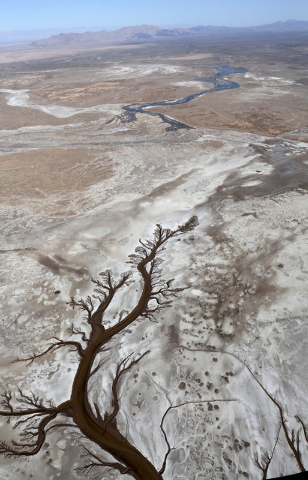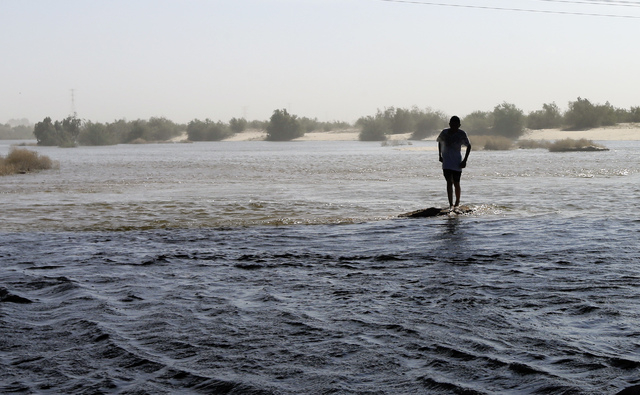Colorado River could reach the sea for first time in decades




In a photo snapped from the air just a few days ago, tendrils of dark brown and blue reach out to each other across an ashen, sun-baked wasteland.
The space between those outstretched fingers shrinks with each passing day, as a man-made flood pushes its way down a long-dry stretch of the Colorado River in search of the sea.
The blue of the river could spill into the brown of the Gulf of California’s tidewater channel during high tide Thursday, based on projections from conservationists and federal officials who are tracking the experimental flood unleashed in late March.
It would mark the first time in 20 years that the Colorado has reached the sea, though such a re-connection was never guaranteed. It wasn’t even really the point of the so-called “pulse-flow,” said Jack Simes, spokesman for the U.S. Bureau of Reclamation.
The goal of the two month, 34-million-gallon experiment was to send water down the river’s historic channel to five restoration sites in Mexico and one in Arizona where researchers are trying to bring back the flood-adapted willow and cottonwood forests that once lined the Colorado’s banks.
“That’s been achieved,” Simes said. “The bonus I guess is if (the water) made it to the sea.”
If that’s going to happen, it needs to happen soon.
The pulse flow is scheduled to end Sunday, when Morelos Dam will close its gates and return to its usual role as the Colorado’s last stop.
By the time the 1,400-mile river reaches the dam, a mile south of where California, Arizona and Mexico converge, nearly all of its flow has been diverted to farms and cities — including Las Vegas, which gets 90 percent of its water this way — across seven western states. What little is left after that barely makes it across the border before it is channeled southwest to crops and communities in Mexico’s Mexicali Valley.
All the old river channel sees south of Morelos Dam is a trickle that vanishes well shy of the delta.
Simes said regular water flow to the Gulf of California ended in the 1960s with the construction of Glen Canyon Dam and the creation of Lake Powell on the Utah-Arizona border.
The last significant release of water to the delta came in 1983, when record flooding on the Colorado caused Lake Mead to spill for the first time. The last time the river reached the sea was in 1993, during heavy flooding on the Gila River, a tributary of the Colorado in southern Arizona.
The pulse flow was made possible by a 2012 amendment to a 70-year-old treaty between the United States and Mexico. Known as Minute 319, the amendment spells out how Mexico will share in shortages and surpluses on the river while allowing that nation to store water in Lake Mead for future use, just as Nevada, Arizona and California do.
The initial pulse of water to the delta eventually will be followed by a small but steady stream of “base flows” totaling about half of the current flood and designed to keep the channel wet during the growing season as the riparian habitat struggles back to life.
A coalition of nonprofit groups on both sides of the border will secure the water for the base flows by buying up temporary water rights from willing sellers in Mexico.
Jennifer Pitt is Colorado River project manager for one of those nonprofits, the Environmental Defense Fund. She considers what man has done to the Colorado “a fundamental disruption of nature,” so seeing the river reach the sea again certainly has symbolic value, even if it wasn’t why the pulse flow experiment was undertaken.
“We’ve been missing that connection for a long time,” Pitt said. “It does feel meaningful. What it will mean from an ecological perspective will be up to the researchers to figure out.”
If the river does reach the gulf on Thursday, the connection will be fleeting. As soon as the flow through Morelos Dam is halted this weekend, there will be nothing left in the river downstream to keep the delta from drying up once more.
Contact Henry Brean at hbrean@reviewjournal.com or 702-383-0350. Find him on Twitter: @RefriedBrean.












